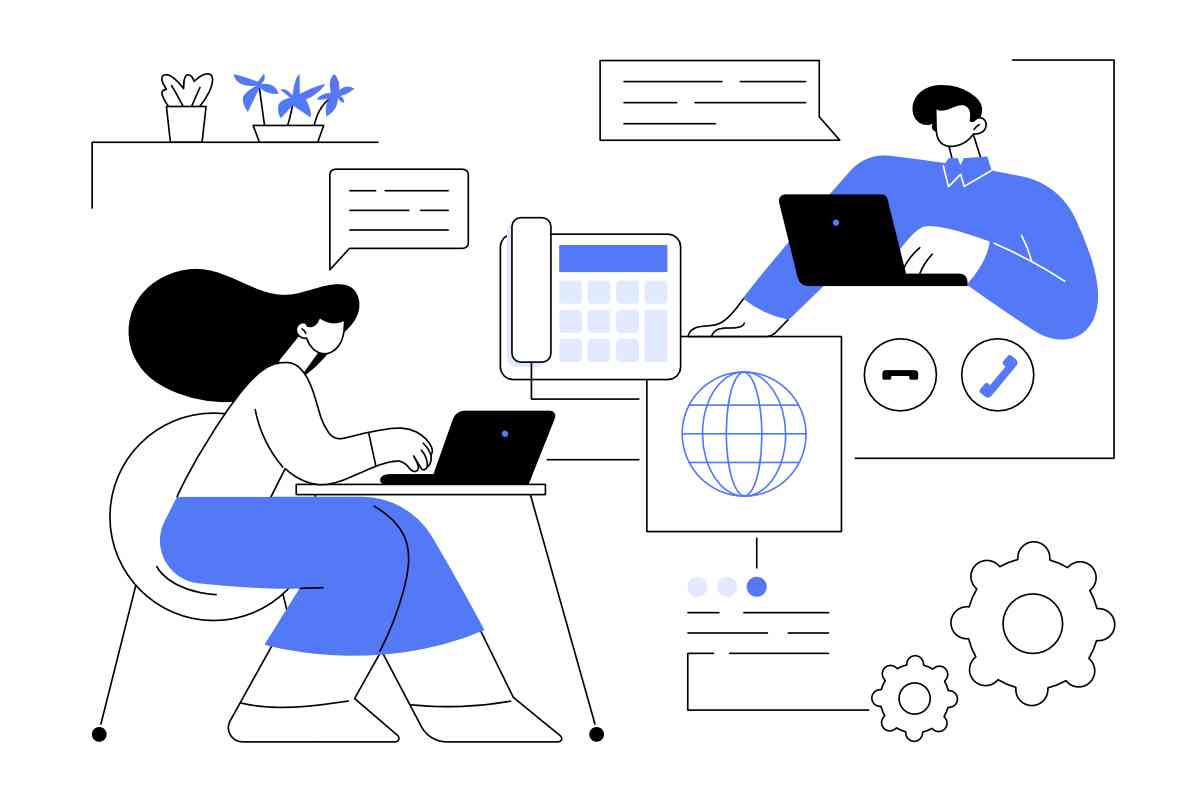With the rapid digital transformation of businesses, especially in a hybrid work environment, choosing the right communication and collaboration platform is vital. Two significant players in this space are Microsoft Teams and 8×8, both offering a comprehensive set of tools tailored to modern business needs. This article will provide an analytical comparison of Microsoft Teams vs 8×8 features and costs, helping you make an informed decision for your UK-based business.
Overview of Microsoft Teams vs 8×8
- Microsoft Teams: Initially launched as a team collaboration tool, Microsoft Teams has evolved into a central hub for work, offering a wide range of integrations, VoIP capabilities, and video conferencing. It’s particularly valuable for businesses already using Microsoft 365, seamlessly integrating with other Microsoft products such as Word, Excel, and OneDrive.
- 8×8: A well-established player in the VoIP and unified communications market, 8×8 offers a cloud-based platform that includes voice, video, messaging, and contact centre solutions. Its robust feature set caters to businesses of all sizes, particularly those looking for a comprehensive communication solution that goes beyond basic collaboration tools.
| Category | Microsoft Teams | 8×8 |
|---|---|---|
| Core Focus | Collaboration and team productivity | Unified communications and VoIP services |
| Collaboration tools | Channels, file sharing, project-based collaboration | Messaging and file sharing, less focused on projects |
| VoIP and telephony | Requires Microsoft Calling Plan or third-party integration | Built-in VoIP with advanced global calling plans |
| Video conferencing | Up to 1,000 participants, screen sharing, breakout rooms, webinars | HD video conferencing, up to 100 participants |
| Contact centre | Not included in basic offering | Built-in contact centre with advanced analytics |
| Integration | Strong integration with Microsoft 365 apps (Word, Excel, OneDrive) | CRM integration (e.g., Salesforce), less project management tools |
| Security | End-to-end encryption, GDPR compliance, multi-factor authentication (MFA) | Encryption for calls and messages, GDPR compliance |
| Scalability | Suitable for small to large enterprises | Suitable for small, medium, and large organisations |
| Free version | Available, limited to basic chat and meetings | No free version, paid plans only |
| Entry-level pricing | Free plan available with basic features | 8×8 Express: £10 per user/month |
| Business pricing | Business Basic: £4.50 per user/month (Microsoft 365 required) | 8×8 X2: £24 per user/month |
| Enterprise pricing | Microsoft 365 E3: £28.10 per user/month | 8×8 X4: £44 per user/month |
| Telephony coverage | UK only with Microsoft Calling Plan | Global coverage with plans including 14-48 countries |
| Video call participant limit | 1,000 participants | 100 participants |
| Suitable for | Businesses looking for collaboration and project management | Businesses needing VoIP and contact centre solutions |
| Pros | Excellent collaboration tools, integrated with Microsoft 365 | Strong VoIP and contact centre features, affordable global calling |
| Cons | Requires Microsoft 365 for best functionality, telephony is a paid add-on | Less collaboration-focused, video conferencing limited to 100 participants |
Summary
- Microsoft Teams is best for UK businesses that prioritise team collaboration, project management, and seamless integration with Microsoft 365.
- 8×8 is ideal for businesses that need VoIP services, global calling plans, and a built-in contact centre, making it more suitable for companies with extensive telecommunication needs.
Key features comparison
Communication tools
- Microsoft Teams:
- Team collaboration: Microsoft Teams excels in fostering collaboration through channels, where team members can work together on projects, share files, and hold meetings.
- Instant messaging: Teams offers text chat with rich media options, like GIFs, emojis, and file sharing, making communication informal yet effective.
- VoIP and telephony: Teams offers integrated VoIP services but requires Microsoft Calling Plans or a third-party provider to enable external calling.
- Video conferencing: Teams allows video meetings with up to 1,000 participants, a standout feature for larger organisations.
- Integration with Microsoft 365: Full integration with other Microsoft apps like SharePoint and OneDrive, enabling seamless workflow and document collaboration.
- 8×8:
- VoIP capabilities: 8×8’s core strength lies in its advanced VoIP features, offering local, national, and international calling capabilities with a global presence.
- Unified communications: The platform includes voice, video, and messaging under one roof, with high-definition video conferencing and advanced call management options.
- Contact centre features: 8×8 provides built-in contact centre solutions, enabling businesses to manage customer interactions across multiple channels (voice, chat, email, etc.).
- Collaboration: While 8×8 offers team messaging and file sharing, it’s less focused on project-based collaboration compared to Teams.
Video conferencing
- Microsoft Teams:
- Offers a well-rounded video conferencing solution with features such as screen sharing, virtual backgrounds, breakout rooms, and recording. It’s especially beneficial for businesses looking to host large webinars or team meetings, integrating with Microsoft 365 for seamless scheduling and file access during meetings.
- 8×8:
- Provides video conferencing solutions that focus on HD video quality and ease of use. Although its features are robust for internal communications and client meetings, it doesn’t offer the same level of customisation or webinar capabilities as Microsoft Teams.
Security
- Microsoft Teams:
- With its deep integration into Microsoft 365, Teams benefits from enterprise-grade security features. These include end-to-end encryption, data loss prevention, and multi-factor authentication (MFA). It complies with major regulations like GDPR, making it highly suitable for UK businesses.
- 8×8:
- 8×8 also offers top-tier security, including encryption for calls and messages, along with compliance with global standards like HIPAA and GDPR. Its built-in contact centre solutions include call recording and monitoring, ensuring compliance and security for customer interactions.
Microsoft Teams vs 8×8 costs comparison
Microsoft Teams pricing
- Microsoft Teams (Free):
- This plan offers basic chat, file sharing, and video conferencing features, ideal for small teams but with limited scalability.
- Microsoft 365 Business Basic (£4.50 per user/month):
- Includes full Teams access, video conferencing for up to 300 participants, 1TB OneDrive storage, and Microsoft Office web and mobile apps.
- Microsoft 365 Business Standard (£9.40 per user/month):
- Adds the full desktop version of Microsoft Office apps, email hosting, and more advanced collaboration features.
- Microsoft 365 E3 (£28.10 per user/month):
- Enterprise-level plan, offering advanced security, compliance features, and Microsoft Teams Calling with 1,000+ participants for video meetings.
8×8 pricing
- 8×8 Express (£10 per user/month):
- A basic plan that includes unlimited calling within the UK, team messaging, and video meetings with up to 100 participants. Suitable for small businesses.
- 8×8 X2 (£24 per user/month):
- Aimed at small and medium businesses, this plan includes unlimited calling to 14 countries, HD video conferencing, and integrations with popular CRM systems.
- 8×8 X4 (£44 per user/month):
- Designed for larger organisations, offering unlimited calling to 48 countries, advanced analytics, call monitoring, and full contact centre features.
Pros and cons
Microsoft Teams
Pros:
- Strong integration with Microsoft 365 tools.
- Feature-rich for collaboration and project management.
- Advanced security features suitable for large enterprises.
Cons:
- Telephony requires additional Microsoft Calling Plans or third-party services.
- Can be overwhelming for smaller businesses not using Microsoft 365.
8×8
Pros:
- Excellent VoIP features and global calling plans.
- Comprehensive contact centre capabilities.
- Affordable pricing for small and medium-sized businesses.
Cons:
- Collaboration features not as extensive as Teams.
- Some users may find it lacks flexibility for integrating with other productivity tools outside the 8×8 ecosystem.
Conclusion – Which is better for your business?
Choosing between Microsoft Teams vs 8×8 largely depends on the specific needs of your business.
- Microsoft Teams is a superior option for businesses already within the Microsoft ecosystem or those seeking an all-in-one platform for project management, collaboration, and communication. Its integration with Microsoft 365 provides excellent value, especially for businesses prioritising team collaboration and productivity.
- 8×8, on the other hand, shines when it comes to unified communications and VoIP services, making it a strong contender for businesses with a global workforce or those looking for a robust contact centre solution. Its pricing is attractive for small to medium-sized businesses, especially those that need advanced telephony features without the additional layers of Microsoft 365.
Ultimately, if your priority is collaboration, project management, and tight integration with office productivity tools, Microsoft Teams is likely the best choice. However, if telephony, global communication, and contact centre functionalities are at the forefront of your requirements, 8×8 may be the more cost-effective and feature-rich solution for your business.
FAQ – Microsoft Teams vs 8×8
Microsoft Teams is mainly for collaboration, file sharing, and communication within teams. 8×8 focuses on VoIP, global telephony, and unified communications, with features like video conferencing and contact centre capabilities, catering to businesses needing robust telecommunication solutions.
Yes, both offer video conferencing. Microsoft Teams supports up to 1,000 participants, ideal for webinars and large meetings. 8×8 supports high-quality video calls for up to 100 participants, making it suitable for smaller meetings and internal communications.
8×8 is better for VoIP, offering global calling plans and advanced telephony features. Microsoft Teams does offer VoIP but requires a Microsoft Calling Plan or third-party integration, making 8×8 more cost-effective for businesses needing comprehensive telephony services.
Microsoft Teams integrates deeply with Microsoft 365, offering seamless access to tools like Word, Excel, and OneDrive. While 8×8 integrates with CRM systems like Salesforce, it lacks the extensive office productivity tool integration that Microsoft Teams provides.
8×8 has built-in contact centre features, including call monitoring, advanced analytics, and omnichannel support. Microsoft Teams does not include contact centre functionality natively, making 8×8 a stronger option for businesses that require customer service management.
Microsoft Teams offers a free version, while 8×8’s entry-level plan starts at £10 per user/month. However, if your business already uses Microsoft 365, Teams can be more cost-effective as it’s bundled with certain plans, whereas 8×8 focuses more on telephony pricing tiers.
Microsoft Teams excels in collaboration, with project-based channels, file sharing, and integration with Microsoft Office tools. 8×8 offers team messaging and file sharing but lacks the robust project management and collaboration features found in Teams, making it less suitable for team-based tasks.
Both Microsoft Teams and 8×8 offer strong security features, including end-to-end encryption and GDPR compliance. Teams benefits from Microsoft 365’s security ecosystem, which includes multi-factor authentication (MFA) and data loss prevention, while 8×8 also ensures secure communication and compliance with global standards.
Microsoft Teams supports up to 1,000 participants in a single video call, making it ideal for large meetings and webinars. 8×8 is limited to 100 participants per meeting, which may not be suitable for larger events or external presentations.
8×8 is more suitable for global businesses due to its international calling plans and built-in VoIP services across 14-48 countries. Microsoft Teams supports global collaboration but requires additional services for telephony, making 8×8 the better choice for businesses with extensive global communication needs.

